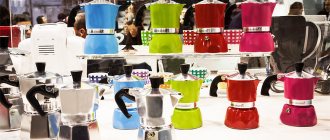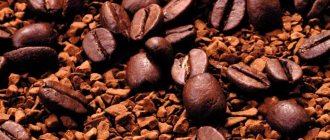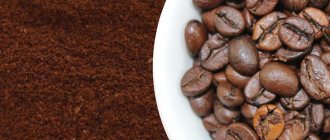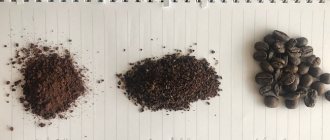Even the most avid coffee lover would hardly be able to list all the varieties of coffee. There are many varieties of coffee beans and drinks based on them. New recipes are constantly being invented. Only by understanding all this abundance will you be able to choose products in accordance with personal preferences and decide on your favorite drinks.
What types of coffee are there?
Varieties and types of coffee are two completely different concepts. By variety we mean all kinds of hybrids that were obtained through selection. In addition, the name “variety” is used to designate coffee products presented on the market. A species is a variety of plants. It is worth considering the most common of them.
Liberica
The plant is called the Liberian coffee tree. The fruits grown on it are exported extremely rarely. As a rule, they are consumed in the country where they grow. This is due to the whimsical nature of culture.
Most plantations are located in Africa. The taste of liberica is bitter, even pungent. Therefore, it is not used to prepare drinks in its pure form, but is added to mixtures. Due to this, they acquire a rich aroma.
Excelsa
It is considered the rarest among the types of coffee crops. He is also called Tall. This is due to the fact that the trees grown reach a height of up to 20 meters. Hand-picked grains have a rich taste and rich aroma.
Arabica
The Arabian coffee tree is considered the most popular. Its fruits are characterized by multifaceted taste and aroma. The culture is capricious and can only be grown in favorable climatic conditions. Sudden changes in temperature at night and during the day are allowed, but frost is unacceptable.
Arabica beans are smooth, long, and contain relatively little caffeine. The drink based on them has a characteristic sourness.
Robusta
The fruits of the coffee tree have a high concentration of caffeine. Due to this, the drink based on them has a bitter taste. As a rule, robusta is included in mixtures to give them strength. The grains are small and have small spots on both sides of the dividing groove.
Growing height
On some coffee packets you may see information about the altitude at which the coffee was grown, usually measured in meters above sea level.
So why should we care? Because the slower a coffee tree grows, the more time it essentially takes for the berries to become saturated with sugars, which contributes to a sweeter and richer taste of the drink.
When comparing two farms in the same region, the one higher up tends to have better climatic conditions. For this reason, the higher altitude at which coffee trees are grown is an indicator of higher quality coffee. But be careful, don't be fooled. After all, for example, at an altitude of 1100 meters in Brazil it will be cooler than in Ecuador.
You also need to take into account the influence of sea currents, wind, and so on. Take the Galapagos Islands, which are located on the equator at an altitude of only 200 meters above sea level and have a cool local climate that produces delicious coffee.
Growing height is useful information when considered in context. Use this when choosing coffee from one region, but don't write off varieties grown at lower altitudes until you've tried them. He may surprise you.
the packaging indicates the growing altitude of 1750 m above sea level, El Salvador coffee from Las Delicias farm, roasted by Smalltime Roasters ©Smalltime Roasters
What varieties are there?
If there are only four types of coffee, then there are significantly more varieties. The list of the most popular includes products grown in South America and Africa.
Brazilian bourbon santos
It is considered the most common among coffee varieties. Trees are grown in Brazil. The drink based on these grains has a chocolate flavor. It contains notes of citrus and almond.
Maragogyp
The most famous variety. The grains are famous for their large size. The drink is aromatic and quite thick. It has a pleasant sweetness. The fruit is grown in Brazil, Mexico and Guatemala.
Medellin
The fruits undergo careful selection before being exported. Therefore, deformed, bad copies do not go on sale. The taste of the prepared coffee is multifaceted and rich.
Colombia Excelso
This variety of coffee beans has a slightly noticeable bitterness and a pronounced cocoa flavor. It is valued by gourmets for its pleasant, unobtrusive sourness. The drink turns out rich, but at the same time delicate.
Maracaibo
The characteristics of the variety grown in Venezuela are not inferior to the Colombian varieties. The drink contains hints of dry wine. There are no analogues to Maracaibo in the world. Therefore, it is often sold at auctions.
Oksaka
The plantations are located in Mexico. The drink based on these grains has a multifaceted taste. It contains shades of nuts and vanilla. There is a slight bitterness.
Antigua and Cobano
These varieties are grown in Guatemala. They are valued primarily for their strength, which gives a charge of vigor. In addition, many coffee lovers prefer these varieties due to the presence of pleasant sourness in the drink.
El Salvador Chalatenango
The variety grown in Brazil can easily be called exquisite. It is characterized by an almond flavor and an unobtrusive floral aroma. Thanks to these properties, it has gained immense popularity.
Ethiopia Mocha
It is considered one of the best varieties. Gourmets call its main advantages a pleasant fruity-wine flavor and an unobtrusive but long-lasting apple aftertaste.
Yemen Moha
The plantations where this type of coffee bean is grown are located on the volcanic slopes in Yemen. A drink based on them is characterized by the presence of sourness and a fruity, sweetish aroma.
The most popular varieties in the world
Australian
The most popular is Arabica Australia Skyberry. This variety appeared in the world relatively recently, but has already won the love of gourmets all over the world, because its qualities are in many ways reminiscent of the favorite, expensive drink of the British royal family - Jamaican Blue Mountain. Taste characteristics – soft taste with a tart note.
Asiatic
- Arabica Yemen Mocha Mattari. For many centuries, the real wealth of Yemen was considered to be spices, incense and a special type of coffee - mattari mocha. The name of the product comes from the area where the plants are grown. It was this variety that first appeared on the territory of Russia and European monarchs drank it with pleasure, for which the drink began to be called “coffee of the lords.” Mocha has unique taste qualities - it can be easily recognized by its light sourness and pleasant chocolate aftertaste. This is one of the most popular single-origin coffees.
- Robusta India Cherry. This variety of Robusta has an incredibly rich aroma and a rather bitter taste with a slight sourness. It is not used as a single variety, but is often added to coffee blends.
Note: the following varieties are very popular - Arabica India Monsund Malabar, the most expensive coffee is recognized as Arabica Indonesia Kopi Luwak, another variation of the famous Blue Mountain - Arabica Papua New Guinea RV.
Arabica South America
- Brazil Santos (Arabica Brazil Santos). The drink has a rich, rather strong taste with a slight sourness and a hint of spice. If you don’t like exotic coffee, but prefer classic coffee, choose this variety.
- Colombia Supremo. The name means magnificent. The drink fully justifies its title - delicate, velvety taste, slightly sweet with a slight wine sourness.
Central America
- Arabica Guatemala Maragogype. It has a spicy taste and a slightly smoky aroma. The drink is valued for its richness and rich flavor bouquet with floral and fruity notes.
- Arabica Guatemala Antigua. It is distinguished by characteristic bitterness and notes of prunes, the aftertaste is light, citrusy with spicy chocolate notes. This variety is chosen by gourmets from different continents.
Types and recipes of coffee drinks
It is quite difficult to understand from pictures and photographs what is included in a particular drink. It is much easier to understand if you study their detailed description.
Espresso
This type of coffee can be called a classic. The coffee drink is prepared in a special coffee machine. At the same time, only 30 ml of water is consumed for 7 g of crushed dark roasted beans. Espresso is served in small ceramic cups. It turns out strong, dense, with thick foam. Many other drinks are prepared on its basis.
Romano
This coffee drink will appeal to connoisseurs of sourness in coffee cocktails. It is prepared by mixing a standard shot of espresso with two tablespoons of lemon juice. Romano is served in small cups. A slice of lemon serves as decoration.
Ristretto
The method of preparing ristretto is similar to espresso. The only difference is the use of less water. Only 25 ml is consumed per serving. This strong drink with a thick consistency is drunk in one sip. It is customary to drink it with cold water. This coffee option is especially popular among Italians.
Mocha
Prepared on the basis of espresso. The list of ingredients also includes:
- chocolate;
- whipped cream;
- milk.
All products are taken in equal proportions (30 ml each).
Making mocha at home is easy. To do this you need to perform several steps:
- Melt the chocolate in a water bath and pour into a glass.
- Immediately after brewing the coffee, pour the hot espresso over the chocolate.
- Warm the milk a little and add to the composition.
- Spread whipped cream on top of the surface.
All components are placed in layers. Mocha has amazing taste and aroma properties. It belongs to the group of sweet desserts.
Latte
Latte is an espresso-based drink. When preparing it, two parts milk is used to one part black coffee. The following actions are performed:
- The milk is divided into two equal parts.
- One half of the milk is simply heated, and the other half is whipped to obtain foam.
- A portion of heated milk is poured into a tall glass goblet.
- Immediately after this, add espresso.
- Milk foam is spread over the coffee.
Syrups can be added to the composition. The surface is often decorated with a pattern. Latte is served in 450 ml glasses. Drink a cocktail through a straw.
Macchiato
In fact, this is one of the variations of coffee with milk. The recipe for making macchiato is incredibly simple. You just need to do a few steps:
- Brew espresso in a coffee maker.
- Pour the hot drink into the cup.
- Place whipped milk on top.
It is not customary to add sugar to the composition.
Cappuccino
Cappuccino is also prepared by first brewing espresso coffee. Milk is used for preparation. They take products in the same ratio as in the case of a latte. The only difference is that espresso is poured into the cup first. After this, add a portion of regular milk, and spread whipped milk foam on top.
Cappuccino does not imply mixing all the ingredients, they must be placed in layers
Viennese coffee
Already from the name it becomes clear that this drink is considered traditional in Austria. It is an espresso with cream and is valued for its rich aroma and delicate taste. When preparing it, the following steps are performed:
- Brew black coffee and pour into a glass.
- Spread whipped cream on top.
- The surface is decorated with chocolate chips, cinnamon or vanilla.
Irish
The preparation of this cocktail is somewhat different from the traditional one. Add 20 ml of whiskey to a shot of hot espresso. The surface is decorated with whipped cream. Sugar is usually not added to the composition. Various toppings can be used. For example, creamy or chocolate.
Americano
It is especially popular due to the lack of characteristic coffee bitterness. Americano is quite light, not strong. To prepare it, you first need to brew a shot of espresso and then add 90 ml of water to it. You can also add sugar to taste. Dessert or cookies are usually served with coffee.
Frappe
This is one of the few famous coffee drinks that uses instant coffee in its preparation. Frappe is especially popular in Greece. To prepare it, follow a number of simple steps:
- Pour a couple of tablespoons of coffee powder into a shaker.
- Pour in 200–300 ml of water.
- Add sugar.
- Then add ice cubes to the shaker.
- The resulting mixture is vigorously whisked and poured into a glass.
Glyase
Refers to those drinks that are served chilled. The recipe for making glace comes down to just a few steps:
- Brew classic espresso.
- After cooling, the coffee is poured into a cup.
- Place a ball of ice cream on top.
- The surface of the ice cream is sprinkled with chocolate chips.
Honey raf
Raf coffee was invented in one of the Russian coffee shops about twenty years ago and in a short period of time gained popularity all over the world. The process of preparing it is quite simple:
- Add cream (100 ml) and honey (to taste) to hot espresso.
- The resulting mixture is whipped with a cappuccino maker.
- Whipped milk foam is carefully placed on top of the surface.
Torre
This drink is also based on a shot of espresso. Quite dense milk foam is placed on top of it. It should rise above the cup by about a couple of centimeters. Torre is served in cappuccino cups.
Processing methods
You can read more in our previous article.
Cutaway coffee berry © Nicolas Rozental
Coffee is actually more than just a bean. It is the seed of the coffee berry, commonly called a "cherry" for its round shape and typical (but not always) bright red color when ripe. But removing the sticky fruit layer is not so easy; special equipment for depulping and subsequent fermentation is often used for this. These processes are called coffee processing, and the processing methods also affect the taste of the coffee. That's why it will be indicated on the coffee pack.
Washed or wet processing
The pulp is removed with water, then the grains are dried. This method does not greatly affect the taste of the coffee, which means you can taste the pure, natural taste of the bean.
Dry or natural method
The beans are slowly dried under the sun while still in the coffee cherry. This method is intended to produce a sweet and fruity taste. But if suddenly the drying is done poorly, the coffee may turn out to be of poor quality and unsatisfactory taste. But, as a result of proper drying, the coffee will be very tasty. It is also an environmentally friendly option.
Honey and half-wash method
Coffee cherries are dried with varying amounts of berry pulp on the coffee bean. The more pulp, the more sweetness and body there will be in the taste.
However, the best way to understand the difference in processing methods is to try it. Get washed and naturally processed coffee from the same region or, better yet, the same farm. Feel these differences for yourself in your cup.
coffee COLUMBIA LA LUNA, washed processing of coffee berries, www.coffeeproject.ru
Similarities and differences between drinks
The basis of coffee drinks is usually espresso. However, they differ from each other in the method of preparation and additional ingredients. For example, latte, cappuccino and macchiato are prepared using the same ingredients, but there are differences between them. Recipes imply different procedures.
In a latte, the first layer is milk, followed by espresso and milk foam. Coffee is initially added to cappuccino. Then add warm milk, which is covered with foam. A macchiato uses only espresso and frothed milk.
Even regular black coffee will be called differently depending on the volume and the presence of additional components. The standard portion of a drink (30 ml) prepared in a coffee machine is espresso. If you reduce the amount of water a little, it will be ristretto, and if you add lemon juice, it will be romano.
Ushakov's Explanatory Dictionary
to about
fe neskl., m. kofi (colloquial) avg. (from Arabic kahva - wine, from the name of the country in Africa - Kaffa). Beans of a tropical plant - the coffee tree. Coffee beans. Ground coffee. Roasted coffee. || A drink made from these grains, roasted and ground. To drink coffee. Mocha. Black coffee. (without cream). Warsaw style coffee. Then he drank his coffee. Pushkin. || A surrogate for this product. Malt coffee. Barley coffee. Coffee made from wine berries.
The portal Gramota.ru states that “ Strict literary norms prescribe the word coffee to be used as a masculine noun: strong coffee has already cooled down. However, in casual oral speech, neuter agreement is acceptable: the coffee is cold.
»
In 2009, the spelling dictionary of the Russian language, edited by Bukchina, in particular, recognized that the word “coffee” now has not only a masculine, but also a neuter gender.
Equipment for preparing coffee drinks
Classic coffee is prepared in a cezve. Coffee beans were brewed in it long before coffee machines were invented. This vessel with a narrowed neck is still used today. An alternative option is a French press. It manages to prepare a fairly strong, aromatic drink. It works on the principle of a press. After infusion, coffee powder is squeezed out in it.
Additional accessories include:
- coffee grinder - can be electric or manual;
- pitcher - designed for frothing milk;
- espresso shot - is a measuring cup that is used when preparing espresso;
- tamper - presses coffee powder when brewing a drink in a coffee machine;
- shaker - used when necessary to mix ingredients.
Unusual devices may also be used. Among them:
- Chemex. It consists of a flask and a funnel connected by a leather rim.
- Purover . The design consists of a funnel with a spiral bottom and a base that is placed on a cup.
- Aeropress . A relatively new invention that is placed on a mug with the filter facing down. Coffee powder is placed in it and water is poured in. The thicket is pressed down with a press.
Aeropress
Chemex
Pour over
Understanding all types of coffee is not as difficult as it might initially seem. Knowing its main types and varieties, you will be able to choose the ideal option for yourself and fully enjoy the taste and aroma of your favorite drink.
Types of coffee by production method
After collecting raw materials, they must be properly processed. Primary processing can be dry or wet. In the first case, the grains are washed and then dried, in the second, after washing they are soaked. After dry processing, coffee retains its natural flavor, and after wet processing, the beans become softer and more elastic.
The next stage is roasting the beans. Coffee can be green, but traditional recipes only use roasted beans. What kind of roasting happens:
- light;
- average;
- strong;
- very strong (highest degree).
Natural coffe
The grind can be coarse, medium, fine. Coarse grinding is usually used for a French press, medium is universal and suitable for coffee makers, and fine grinding is used to prepare a drink in coffee machines and brewed in Turks.
In order to sort the grains, they are sifted through devices similar to a sieve with different cells. Unroasted green beans come in the following sizes:
- very small;
- small;
- small;
- average;
- large;
- very big.
The grain size does not affect the taste of the drink. You need to measure the beans in order to roast them correctly. Large grains are more difficult to roast evenly than small ones.
Types of instant coffee
Instant coffee has many fans, which is explained by the invigorating properties of the drink, acceptable taste, and affordable price. Instant coffee has a milder taste and takes very little time to prepare.
Range
The tables present companies occupying the main segments of the coffee market.
| Coffee market segments/Companies | ||
| Green | Naturally roasted and ground | Soluble |
| Bernard Rhodes | Russian product | Nestlé (Nescafe) |
| Orimi trade | Chibo | Chibo |
| Orimi trade | Kraft Foods (Maxwell House and Jacobs) | |
| Kraft Foods | Russian product | |
| Kappa | Grandee | |
| Moscow coffee shop on shares | Moscow coffee shop on shares (Arabica and Colombo) | |
| Bowling | NEP (Jockey, Jardine) | |
| Golden Domes (Black Card brand) | Seda International (Ambassador brand) | |
| Golden Domes (Black Card brand) | ||
Beans and ground coffee are mainly Arabica, less commonly a mixture of Arabica and Robusta. Bean coffee is found in large supermarkets and small specialty shops. Retail outlets that sell “a little bit of everything” usually offer instant coffee. Sales ratio in the instant coffee segment
The leading companies that divided the instant coffee market are presented in the diagram
| Manufacturer | Product type | Advantages | Price range |
| Grand Classic, Brazil | spray, no artificial flavors, | Pleasant taste and aroma | LOW (relatively low price) |
| Grand Classic, Brazil | Ground, Arabica quality, unflavored | Pleasant taste and aroma | LOW (relatively low price) |
| Golden Domes (Black Card) | Cereal, ground, instant | Pleasant taste and aroma | LOW (relatively low price) |
| NEP (Jockey, Jardine) | Cereal, ground, instant | Pleasant taste and aroma | LOW (relatively low price) |
| Kraft Foods | Instant, ground, grain (Arabica) under the Jacobs and Maxwell House brand | The aroma is preserved using special packaging | Moderate (average price range) |
| Nestle | The products are sold under the Nescafe brand: in the form of sublimate, granules, capsules, ground coffee | Has a pleasant, delicate taste | Moderate (average price range) |
| Thcibo (Chibo) | Ground and beans. There are 5 main varieties of coffee on the market: Espresso (Milano Style, Sicilia Style), Golden Collection, Exclusive and Mild (high quality Arabica) | Rich aroma, rich taste | Moderate (average price range) |
| Live coffee | Ground and beans (Mocha, Espresso, Bourbon), high quality Arabica | Moderate (average price range) | |
| Lavazza, Italy | Ground, grain, Arabica | Considered one of the best brands | Moderate (average price range) |
| Moscow coffee shop on shares | Grain, Arabica | Moderate (average price range) | |
| Italy Bianca | Grain (Arabica, Robusta) | Soft rich taste, thick foam | Moderate (average price range |
| Seda International (Ambassador) | Cereal, instant, ground | Moderate (average price range | |
| Coffee Yemen Mocha Matari | Grain, Arabica | Spicy chocolate taste with a fruity aftertaste | Premium |
| Coffee Blues Australia Skybury | Grain, Arabica (ribbed variety) | Subtle aroma, rich taste with notes of flowers, spices and dark chocolate | Premium |
By growing height above sea level
Traditionally, high-mountain varieties are considered elite. The following markings are found on the packages:
- SHG - grains that grew in mountainous areas at an altitude of 1500 to 2000 m;
- HG - coffee was grown in the foothills (1000 - 1500 m);
- CS or MG - plantations are located on the plains.
There are designations SHGW and HGW. The last letter means that wet processing was used in the foothills or mountain areas.
By type of grinding
To make coffee, you need to grind the fruits. In everyday life, the degree of grinding is determined by touch.
Large
The maximum particle diameter is 1 mm and resembles coarse salt in appearance. It is obtained after grinding the beans in a home coffee grinder for 10 seconds. It is not found in retail sales; it is more often used during tastings.
Average
This method is universal. Coffee resembles fine sand. To obtain it, it is enough to hold the fruits in a coffee grinder for 10-15 seconds.
Small
The grains are ground to fine salt or powder. The first option is ideal for a coffee machine, the second - for brewing in a Turk. Grinding duration is up to 20 seconds. This releases caffeine, which contributes to bitterness.
Classification according to the quality of raw material preparation
The packaging may contain the letters A, B and C, which correspond to high, medium and low quality. Some manufacturers prefer the following markings:
- AA - the best;
- AB - good;
- VA - average;
- BB - low quality.
For manual processing, American (AP) and European (EP) preparation methods are used. The first marking provides for the elimination of 23 defects in 300 g of grain, the second - 8 defects in a similar weight.











